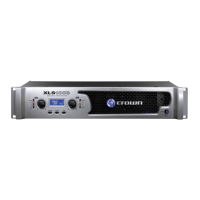The High Frequency Feedback comes directly from the switching node at the junction of
the output MOSFETs and the input to the output filter at L101. This signal has the full
switching signal on it and therefore must be filtered. R139/140 and C176 provide the first
filtering to attenuate the VHF spectrum. The next filter is a notch filter tuned to the
384KHz switching frequency and includes R139/138/137/136 as well as C137/138/139.
This notch filter attenuates the switching frequency and passes it on to the next 2 filtering
done by C136 and C135. This additional filtering helps to keep the switching noise out of
the feedback while allowing the audio band signals to pass at an attenuated level to
U101A.
The feedback summing is done by resistor/capacitor network at R126/127/128/129
C130/131/132. This summing combines the HF Feedback and LF Feedback in equal parts
to create a resultant full audio band feedback. U101C does the function of buffering the
summed feedback and adds phase lead ( C128/129; R125 ) to improve stability margin.
The feedback signal out of U101C is then further filtered by the 2
nd
harmonic (768KHz)
trap comprised of R116/117/118/119 and C122/123/124. Passing through R115 we are
back to the combining point of the input signal and the feedback which as stated earlier
goes to the Ruby (U1) error amplifier.
The Ruby signal path.
Before the Ruby IC (U1) will pass a signal the STBY pin (17, 18) must be pulled high.
This line is an open collector output/input on Ruby so an external source can pull the pin
low to inhibit PWM switching ( Q101 ) or the Ruby IC can pull the line low in case of a
Ruby determined fault condition. This pin must be high for the Ruby to be enabled.
The ruby error amplifier uses a triple integrated feedback (C116-121 and R109-111) to
maximize the amount of feedback in the audio frequency range. R142 and C158 provide
a high frequency load for the error amp to improve the internal opamp stability. Inside of
the Ruby IC the resultant error signal is compared to the Ruby generated triangle wave
which creates the PWM signal used to drive the Output Stage. Ruby varies the amplitude
of the triangle wave based on the Vcc voltage it senses through R7-10 which it also uses
for an overvoltage protection circuit. U2-B is a buffer/filter for the Ruby Reference
Voltage called VR on the schematic. This VR signal connects directly to the Ruby error
amp and must be highly filtered to reduce noise injected into the feedback.
The Output Stage.
The PWM signal from Ruby ( pin 54 ) drives the gate drive IC (U102). The transistors
Q102 and Q109 use the PWM signal to determine if the gate drive IC should be enabled
and will only enable U102 if there is a valid PWM signal coming from Ruby. U102 does
several functions. First it translates the signal from the ground referenced signal that
Ruby provides to signals capable of driving the MOSFETs that are referenced to –Vcc
(Q104) and to the switching node (Q103). This drive signal is buffered by Q110-113 in
order to provide adequate current to drive the MOSFETs.

